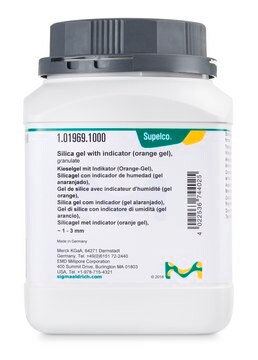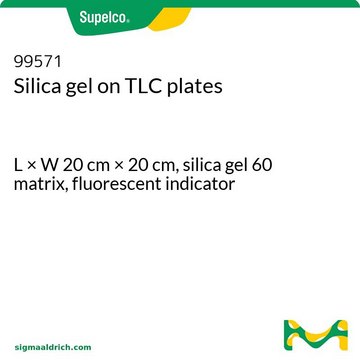60765
Gel de sílice
high-purity grade, with ~15% calcium sulfate and fluorescent indicator, GF254, suitable for thin layer chromatography (TLC)
About This Item
Productos recomendados
grade
high-purity grade
Quality Level
form
powder
quality
with ~15% calcium sulfate and fluorescent indicator
manufacturer/tradename
Sigma-Aldrich
technique(s)
thin layer chromatography (TLC): suitable
surface area
500 m2/g
particle size
<20 μm
>632 mesh
pore size
0.8 cm3/g pore volume
60 Å pore size
bp
2230 °C
mp
>1600 °C
SMILES string
O=[Si]=O
InChI
1S/O2Si/c1-3-2
InChI key
VYPSYNLAJGMNEJ-UHFFFAOYSA-N
¿Está buscando productos similares? Visita Guía de comparación de productos
General description
a. Aquagel - pores are filled with water
b. Xerogel - by the process of evaporation, aqueous phase in the pores are removed
c. Aerogel - solvent is removed by supercritical extraction
Application
- Chromatographic Separation: Silica gel is widely used as a stationary phase in chromatography for the separation of various chemical compounds. Innovations in silica gel modification, such as pentabromobenzyl group-modified silica gel, have enhanced the separation efficiency for metabolites like nicotinamide. This application is critical for pharmaceutical analysis and metabolomics studies, providing high precision and accuracy in the quantification of biologically relevant molecules (Ozaki et al., Analytical Biochemistry, 2022).
- Environmental Pollutant Detection: Silica gel is used to create molecularly imprinted polymers (MIPs) that selectively recognize and bind environmental pollutants. A notable application involves the embedding of quantum dots in molecularly imprinted silica gel to detect aminoimidazo-azaarenes (AIAs) in food samples. This method offers high selectivity and sensitivity, making it a powerful tool for food safety and environmental monitoring (Qiao et al., Current Analytical Chemistry, 2021).
Storage Class
11 - Combustible Solids
wgk_germany
nwg
flash_point_f
Not applicable
flash_point_c
Not applicable
ppe
Eyeshields, Gloves, type N95 (US)
Elija entre una de las versiones más recientes:
¿Ya tiene este producto?
Encuentre la documentación para los productos que ha comprado recientemente en la Biblioteca de documentos.
Los clientes también vieron
Nuestro equipo de científicos tiene experiencia en todas las áreas de investigación: Ciencias de la vida, Ciencia de los materiales, Síntesis química, Cromatografía, Analítica y muchas otras.
Póngase en contacto con el Servicio técnico


